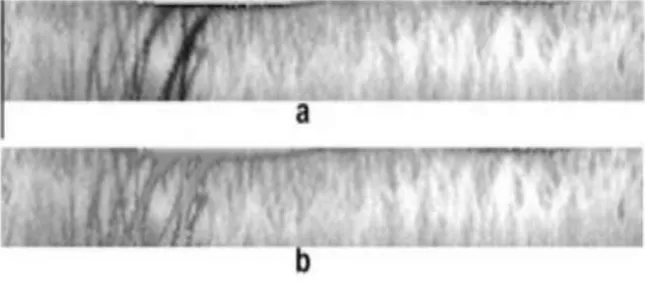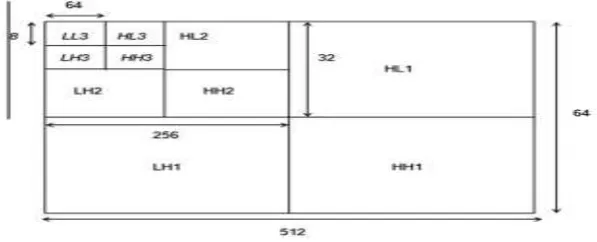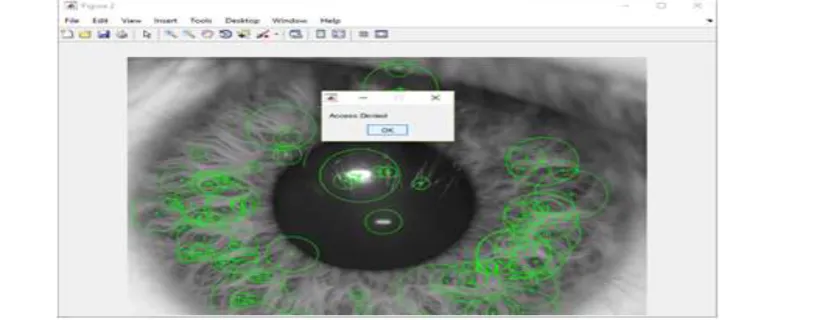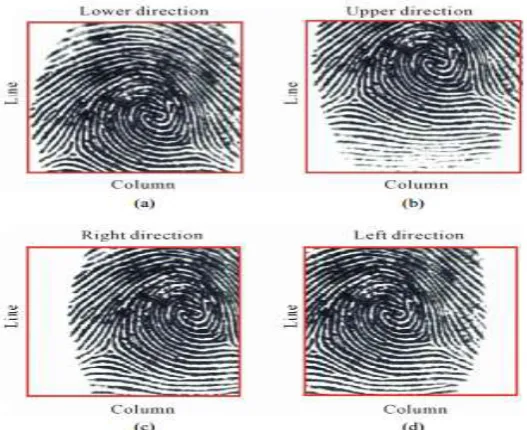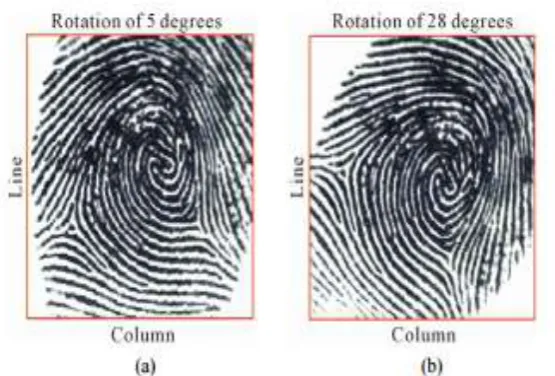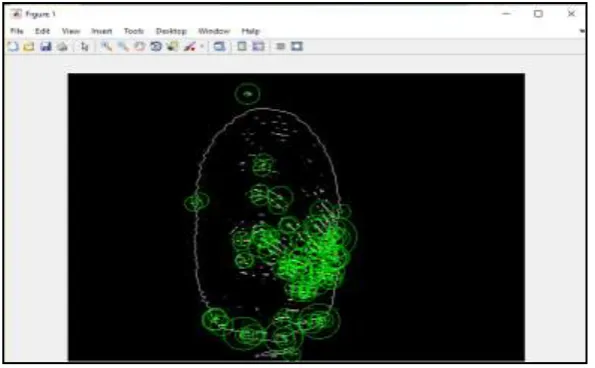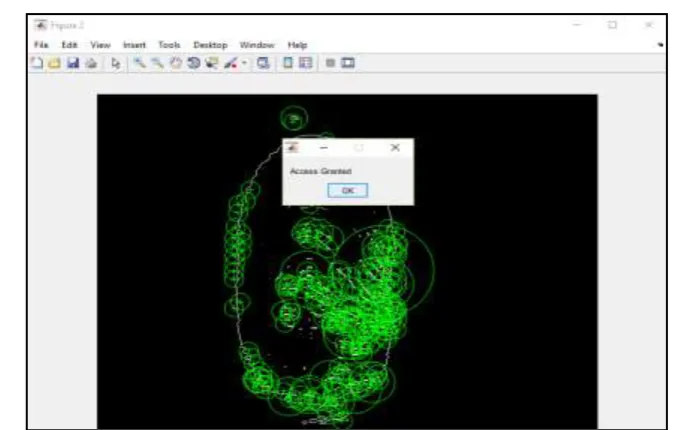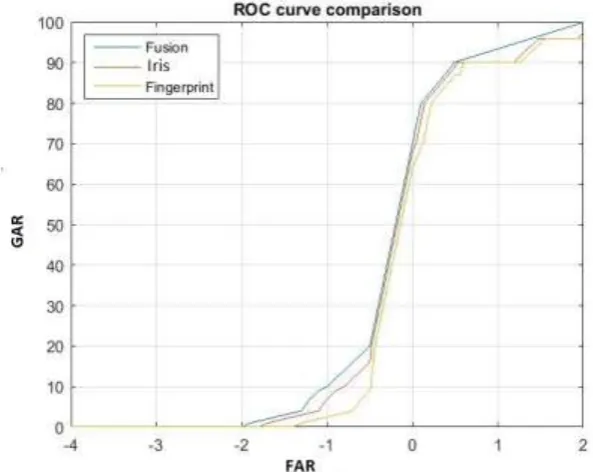e-ISSN: 2278-067X, p-ISSN: 2278-800X, www.ijerd.com
Volume 12, Issue 8 (August 2016), PP.12-26
An Efficient Biometric Multimodal Fingerprint and Iris using an
SVM Classifier and Adaptive Neuro Fuzzy Inference
System (ANFIS)
Rinky Ahuja, Kiran Khatter
Abstract:
Recent times witnessed much advancement in the field of biometric and multimodal biometric fields. This is typically observed in the area, of security, privacy, and forensics. Even for the best of unimodal biometric systems, it is often not possible to achieve a higher recognition rate. Fusion of matching scores of multiple biometric traits is becoming more and more prevalent and is a very likely approach to boost the system's accuracy. The finger print and iris are among the most promising biometric authentication that can accurately identify and analysis a person as their unique qualities can be rapidly extracted during the recognition process. This biometric recognition and verification often deals with non-ideal scenarios such as faint images, off-angles, reflections, expression changes. In this work, a novel method for identification of fingerprint and IRIS is projected using an ANFIS-based matching algorithm, which is suitable for large-scale identification systems. An important feature and objective of the proposed system is to enhance accuracy and efficiency. The features of the fingerprint and Iris image is extracted using SIFT algorithm. The features are perfectly extracted from fingerprint and eye image using this algorithm. Then the extracted features are given to the Regressive SVM and Hamming Distance classifier. The regressive support vector machine and hamming distance is used as a classifier, it accurately matches the two set of fingerprint and iris features quickly.Keywords: Biometric recognition, ANFIS, SIFT, Support Vector Machine (SVM), Hamming Distance.
I.
INTRODUCTION
With the benefit of reliability and stability, biometric recognition has been emerging speedily for safety and personal identity recognition. Protecting resources from an intruder is a crucial problem for the owner. The multimodal biometric system integrates more biometrics to improve security and accuracy and hence is capable of handling more proficiently the non-universality problem of human qualities. In fact, it is very common to use a variety of biological features for identification as different biological characteristics are knowingly/unknowingly used by people to recognize an individual.
Fusion of several biometric traits provides more valuable information compared to that acquired using unimodal biometric feature. Use of diverse feature extraction methods from each modality possibly covers some features those are not caught by the first method. Supplementary information on the same identity helps in achieving high performance [1]. Prevalent practices in multimodal fusion are broadly categorized as prematching and postmatching fusion [2]. Feature level fusion is prematching activity. Fusion at the feature level comprises of the fusion of feature sets relating to several modalities. The feature set grasps richer information about the raw biometric data than the match score or the final decision. Assimilation at feature level is likely to offer good recognition results. But fusion at this level is tough to accomplish. The information acquired from dissimilar modalities may be so heterogeneous that process of fusion is not so easy. The sequential and parallel feature fusion results in high-dimensional feature vector. The reduced the number of biometric traits, the lesser the time required for feature fusion. The more number of traits covers more information. To accomplish a better recognition rate with reduced processing time is the primary objective of this work.
Matching Score level fusion trained by the SVM-based classifier is used in the proposed work for assessing the performance of the proposed system. The idea behind the SVM is to map the input vectors into a high-dimensional feature space using the ―kernel trick‖ and then to build linear decisions function in this space so that the dataset becomes separated with a extreme margin [3–6]. The features of the fingerprint and Iris image is extracted using SIFT algorithm. The features are perfectly extracted from fingerprint and eye image using this algorithm. Then the extracted features are given to the SVM and hamming distance classifier. This research work aims at reducing the false rejection, false acceptance, and training and testing time for reliable recognition.The remainder of this paper is organized as follows. Section 2 briefly presents the review of existing multimodal biometric systems. Section 3 describes the main modules of the proposed multimodal biometric recognition system. Section 4 presents results of iris recognition. Section 5 presents the results of fingerprint recognition. Section 6 describes the fusion process and its result. Finally Section 7concludes our research.
II.
LITERATURE REVIEW
In recent times, multimodal biometric systems have attracted the consideration of researchers. A diversity of articles can be found, which propose diverse methodologies for unimodal and multimodal biometric systems which are [1, 2, 7–11]. Multimodal fusion has the synergic effect increasing the value of information. First multimodal biometric was proposed by Jain and Ross 2002 [7]. Later, various scientists thrive for plenty of research in multimodal biometric system. A great deal of academic research was dedicated to it. A number of published works decide that the fusion process is in effect, as fused scores offer greater discrimination than individual scores [1, 2]. Huge literature deals with a variety of techniques making the features more informative [6–9]. Single input and numerous algorithms for feature extraction [6] or various samples and single feature extraction algorithm [12] or utilizing two or more diverse modalities [13] are commonly discussed in recent times. It was found in [14] that the empirical relation in multimodal biometrics can improve the performance. But these improvements involve the price of various sensors or multiple algorithms, which finally reflects greater installation and operational cost.
In maximum cases, multimodal fusion can be categorized into two groups: prematching fusion and postmatching fusion. Fusion prior to matching incorporates pieces of evidence before matching. It consists of sensor level fusion [7] and feature level fusion [15, 16]. Fusion after matching incorporates pieces of evidence after matching. It consists of match score level [17-19], rank level [20, 21], and decision level [22]. Fusion at the decision level is too rigid as only a limited amount of information is obtainable at this level [23]. Combination at the matching score level is normally favoured due to the comfort in retrieving and joining matching scores. Since the matching scores produced by dissimilar modalities are heterogeneous, it is vital to normalize the scores before merging them. Normalization is computationally costly [14].
Choosing unsuitable normalization technique may result in low recognition rate. For pleasant and actual working of the system, cautious selection of different environments, different set of traits, different set of sensors, and so forth are necessary [14]. The features encompass richer information about the input biometric data than the matching and decision scores. Integration at the feature level should deliver superior recognition results than other levels of integration [15, 16, 23].
However feature space and scaling differences make it problematic to homogenize features from different biometrics. Fused feature vector occasionally may result in bigger dimension, compared to unimodal features. For instance, fused vector is expected to end up with twice the dimension of unimodal features. For fusion to attain the claimed performance improvement, fusion rules must be selected based on the type of application, biometric traits, and level of fusion. Biometric systems that integrate information at an initial stage of processing are supposed to be more effective than those systems which perform integration at a later stage.
In what follows, we present a brief analysis of some recent researches. The unimodal iris system, unimodal palmprint system, and multibiometric system (iris and palmprint) are presented in [17]. They worked on the matching score on the basis of resemblance of the query feature vector with the template vector.
Besbes et al. [22] projected a multimodal biometric system using fingerprint and iris features. They use a hybrid methodology based on (1) fingerprint minutiae extraction and (2) iris template encoding through a mathematical representation of the extracted Iris region. This methodology was based on two recognition modalities, and every part delivers its own decision. The final decision was acquired by ANDing the unimodal decision. Experimental verification of the theoretical claim is missing in their work.
statistical parameters was used. They used the fingerprints of both thumbs. Each fingerprint was individually processed, and the unimodal results were joined to acquire final fused result.
Yang and Ma [19] used fingerprint, palm print, and hand geometry to implement personal identity verification. The three images were derived from the similar image. They implemented matching score fusion to establish identity, performing first fusion of the fingerprint and palm-print features, and later a matching-score fusion amongst the multimodal system and the unimodal palm geometry.
An approach recommended in [25] shows better data fusion for face, fingerprint, and iris images. The approach was grounded on the eigenface and the Gabor wavelet methodologies, incorporating the benefits of the single algorithm. They suggested a new fusion system that exhibited better performance.
Baig et al. [26] worked on the state-of-the-art framework for multimodal biometric identification system. It is adjustable to any kind of biometric system. Quicker processing was benefits of their system. A framework for fusion of the iris and fingerprint was established for verification. Classification was based on single Hamming distance. An authentication method offered by Nagesh Kumar et al. [18] emphases on multimodal biometric system with two features, that is, face and palm print. Integrated feature vector caused in the robustness of the person authentication. The final assessment was completed by fusion at the matching score level. Unimodal scores were fused after matching. Maurer and Baker have presented a fusion architecture based on Bayesian belief networks for fingerprint and voice [27]. The features were modelled using statistical distributions.
A frequency-based method resulting in a homogeneous biometric vector, integrating iris and fingerprint data, is worked out in [23]. Successively, a hamming-distance-based matching algorithm dealt with the unified homogenous biometric vector. Basha et al. [20] executed fusion of iris and fingerprint. They used adaptive rank level fusion directly at authentication stage. Ko [28] worked on the fusion of fingerprint, face, and iris. Numerous opportunities of multimodal biometric fusion and strategies were discussed for improving accuracy. Evaluation of image quality from unlike biometric and their effect on identification accuracy was also discussed. Jagadeesan et al. [15] prepared a secured cryptographic key on the base of iris and fingerprint features. Minutiae points were extracted from fingerprint. Correspondingly texture properties were extracted from iris. Feature level fusion was further employed. 256-bit cryptographic key was the consequence of the fusion. Enhancement in authentication and security, using 256-bit encryption, was claimed as a part of their result in [15]. A multimodal biometric-based encryption scheme was suggested by [16]. They combine features of the fingerprint and iris with a user-defined secret key.
As far as multimodal biometric-based encryption schemes are concerned, there are very little proposals in the literature. Nandakumar and Jain [29] projected a fuzzy vault-based scheme that combines iris with fingerprints. As expected, the verification performance of the multi-biometric vault was superior than the unimodal biometric vaults. But the increase in entropy of the keys is only from 40 bits (for individual fingerprint and iris modalities) to 49 bits (for the multibiometric system). Nagar et al. [30] offered a feature-level fusion framework to simultaneously defend multiple templates of a user as a single secure sketch. They executed framework using two well-known biometric cryptosystems, that is, fuzzy vault and fuzzy commitment.
In contrast to the methodologies found in the literature and detailed earlier, the proposed approach presents a novel method for recognition of fingerprint and iris patterns using a combination of support vector machine and Hamming distance. The zigzag collarette area of the iris is selected for iris feature extraction because it captures the most important areas of iris complex pattern and higher recognition rate is achieved.Geometric transform is done for making the geometric alignment of the two fingerprint images. The turns and edges are identified using ridge let transform. Extraction of features from multimodalities, their fusion using distinct process, and classification using regressiveSVM are the core of this work. The proposed fusion method is not used earlier in any research. The novelty of the work is to create a single template from two biometric modalities and the use of regressive SVM for recognition purpose.
III.
RESEARCH METHODOLOGY
Fig. 1 Flow chart of the application showing the main modules of the multimodal biometric recognition system A novel method for identification of fingerprint and IRIS is projected using an ANFIS-based matching algorithm, which is suitable for large-scale identification systems. In this ANFIS algorithm, the Gabor transform and minutia extractor is used to extract features of fingerprints and IRIS.
Fig 1.depicts the Block diagram of the enhanced multimodal biometric recognition system using bio inspired algorithm integrating finger print and IRIS recognition. Fingerprint recognition and IRIS recognition involves the pre-processing of image, extraction of finger impairment and eye impairment, matching of finger print and IRIS and decision-making. In the effective execution phase, the two biometric sensors captures the finger print and IRIS biometric characteristics independently from the person to be recognized and transfer them to a raw digital layout, which are additional processed by the extraction segments separately to produce a representation that is of the similar format as the templates which is stored in the resultant databases under bio inspired algorithm bases. The two resulting representations are then transferred to the two corresponding matching modules such as finger print and IRIS. Here, both finger print and IRIS recognition are matched with templates in the resultant databases to find the likeness between the two feature sets. The matching notification percentage created from the separate recognizers is then accepted to the fusion module. Finally, fused matching of each individual is identified as (Final = Finger + IRIS) and is delivered to the decision module where an individual is acknowledged as genuine or a scam and transferred to USER ID number display.
IV.
IRIS RECOGNITION TECHNIQUE
4.1 Iris Recognition Technique
Fig.2 Flow diagram of Proposed System.
4.1.1 Hough Transform
The Hough transform is a technique that can be used to determine the parameters of simple geometric objects, such as lines and circles existing in an image. The circular Hough transform can be employed to deduce the centre and radius coordinates of the pupil and iris regions, when a number of points that fall on the perimeter are well-known [31]. A circle with radius r and centre (xc, yc) can be defined by the parametric equations
x = xc + r * cosɵ(1) and y = yc + r * sin(ɵ) (1)
When the angle sweeps through the full 360o range, the points (x, y) trace the perimeter of a circle. If an image encloses numerous points, some of which fall on the perimeters of circles, then the work of the search program is to discover co-ordinate triplets (xc, yc, r) to define each circle The procedure of finding circles in an image by circular Hough transform is: First we discover all edges in the image. This step has nothing to do with Hough Transform and any edge detection method can be used.
4.1.2 Isolation of Zigzag Collarette Area
The zigzag collarette area of the iris is selected for iris feature extraction as it captures the most significant areas of iris complex pattern. It is not very much affected by eyelids and eyelashes for the reason that it is closed with the pupil. The previously acquired centre value of pupil is used for finding of collarette zigzag area because it is generally concentric to pupils and radius of this part of the iris is limited in a certain range.
4.1.3 Eyelid Detection
Two search regions are selected for the purpose of upper and lower eyelids detection. The search regions are restricted within the pupil and zigzag collarette area of the iris.
Width of search region = radius of iris (Zigzag area) - radius of pupil (2)
A horizontal edge map is used to find an edge image of an eye image as eye lid part is existing in upper or lower horizontal region. At every edge point inside the search regions, a parabolic Hough transformation is applied for eyelids detection.
4.1.4 Normalisation and Eyelash Removal
Fig. 3 Normalisation process.
In this work eyelash removal technique is applied after the normalisation process. A method for eradicating eyelashes and restoring the essential iris pattern as much as possible is developed. In this step the zigzag collarette area pixels which are obstructed by eyelashes are recreated using information from their non-occluded neighbours. For every pixel (x,y) existing in the normalised image we first decide whether the pixel is occluded by eyelash or not.
If I(x,y) < T, pixel is occluded by eyelash (3)
where I is the intensity of a pixel and T is a threshold. For every pixel which satisfies Eq. (3), a 5 x 5 median filter is applied on that pixel. In 5 x 5 neighbourhoods only those pixels which are greater than T are selected as they are not obstructed by an eyelash. At last we sort all pixels in ascending order and centre pixel value is substituted with the median value of 5 x 5 window neighbourhoods. Fig. 4 shows the effect of applying eyelash removal technique on normalised image
Fig. 4 Eyelash removal
4.2 Feature Extraction and Matching
Once the segmented iris region was normalised the relevant texture information needs to be extracted. In this work two methods for feature extraction are proposed. First one is Split and construct algorithm and the second one is 1D Log Gabor wavelet. For the purpose of classification; regressive support vector machine is used as a main classifier while Hamming distance is used as a secondary classifier.
4.2.1 Feature Extraction
4.2.1.1 Split and Construct Algorithm
major characteristic region. The values of LL3 region are used as components of the characteristic input vector to regressive SVM.
Fig. 5 Split and Construct Algorithm
4.2.1.2 ID Log Gabor Wavelet
Feature encoding is executed by convolving the normalised iris region with 1D Log-Gabor wavelets. First the 2D normalised pattern is broken into a number of 1D signals and then these 1D signals are convolved with 1D Gabor wavelets. Each row of 2D normalised pattern is taken as the 1D signal and corresponds to a circular ring on the iris region. The angular direction is taken rather than the radial one, which parallels to columns of the normalised pattern, since maximum independence occurs in the angular direction [34]. To avoid the influence of noise in the output, the intensity values at known noise areas in the normalised pattern are set to the average intensity of neighbouring pixels. The output of filtering is then phase quantised to four levels using the Daugman [32], with each filter producing two bits of data for each phase. The output of phase quantisation is selected to be a grey code, so that when going from one quadrant to another, only 1 bit changes. This will reduce the number of bits disagreeing, if say two intra-class patterns are to some extent misaligned and thus will provide more correct recognition. The encoding process produces a noise mask along with bitwise template. The generated bitwise template and corresponding noise mask is further used for classification purpose.
4.2.2 Matching
In the matching process, any iris image is given to the combined regressive SVM and Hamming distance based classification approach. The output from both SVM and hamming distance are evaluated and tabled and the person who is having more similar scores for both Regressive SVM and Hamming distance are declared as genuine one.
SVM classifier is a linear classifier based on maximum margin assumption. It performs very well in many linear classification applications. It is not found to be efficient in nonlinear classifications, although, it can be extended to nonlinear cases by exploiting the idea of kernel. This works by finding a classifier which maximizes the conditional likelihood of the training data. With that the relation between the data can be found and it will be more accurate than the existing one.
Improvements in proposed algorithm:
Regression SVM assumes that the predictors were not sufficient to determine the response variable, but determine a probability that is a non-linear function of a linear combination of them. If there's a lot of noise, logistic regression (usually fit with maximum-likelihood techniques) is a great technique.
Additionally, SVMs only consider points near the margin (support vectors). Regression SVM’s considers
all the points in the data set which you prefer depending on your problem. Hence it is more efficient.
For those irises which are not classified by SVM, Hamming distance is calculated for all training images. For the CASIA image database, four images of each class were used for training and remaining three were used for testing purpose. If there are n person (classes), then
Si = (hd1 + hd2 +hd3 +hd4)/4 (4)
𝐴𝑢𝑡𝑒𝑛𝑡𝑖𝑐𝑖𝑡𝑦 = 𝑇𝑟𝑢𝑒, 𝑖𝑓 𝑆 < 𝑇
𝐹𝑎𝑙𝑠𝑒, 𝑂𝑡𝑒𝑟𝑤𝑖𝑠𝑒 (5)
4.3 Experimental Results for Iris Recognition
The proposed iris algorithm is implemented in MATLAB. We have taken three sample images from CASIA v4 database maintained by the Chinese Academy of Science [CASIA]. Results are as follows:
STEP 1: First of all, two sample images need to be opened in MATLAB.
Fig. 6 Opening two Iris images
STEP 2: Iris region is localised, and the points with higher pixel values shown in green colour are matched according to proposed algorithm.
Fig. 7 Iris region with high pixel values (Region of Interest)
STEP 3: If the two iris images are same, then the message ―Access Granted‖ appeared showing that the user seeking some service is a genuine user.
In our case, we have taken two different images and the message ―Access Denied‖ appeared showing that the user is some impostor.
V.
FINGERPRINT RECOGNITION TECHNIQUE
Fingerprint is one of the most widely used biometric modality. The fingerprint is basically the combination of ridges and valleys on the surface of the finger. The main reason behind the use of fingerprint biometric is that it is the most proven technique to identify the individual. The major steps involved in fingerprint recognition using minutiae matching approach after image acquisitions are:
1. Image Enhancement
2. Minutiae Extraction
3. Matching
5.1 Noise Removal using Median Filter
The median filter considers each pixel in the image in turn and looks at its nearby neighbours to decide whether or not it is representative of its surroundings. It is similar to noise removal in Iris image.
5.2 Spatial Misalignment Correction
Fingerprint image alignment algorithm is the most important step in any fingerprint based recognition systems since the results of minutia extraction algorithms and the minutia matching algorithms are very much depend on the clarity and orientation of the fingerprint image. We used clustering based fingerprint image rotation algorithm to improve the performance of the fingerprint recognition system.
Fig. 9 An example of the original genuine fingerprint image
Fig. 11 Two examples of the scanned genuine fingerprint images having the rotation misalignment with original fingerprint image, when the rotation angles are (a) 5 degrees and (b) 28 degrees.
5.3 Fingerprint Image Binarization
Image binarization is a process which transforms the 8bit grey image to a 1bit image with 0 value for ridges and 1 value for valleys. After the operation, ridges in the fingerprint are highlighted with black colour while valleys are white. Binarization is done to increase the contrast between the ridges and the valleys and hence, facilitates the extraction of minutia.
5.4 Fingerprint Image Ridge Thinning
Thinning is the process applied over binarized image, by thinning certain pattern shapes until it is represented by 1-pixel wide lines.
Fingerprint thinning is usually implemented via morphological operations such as erosion and dilation to reduce the width of ridges to a single pixel. The extent and connectivity of the original shape is preserved.
5.5 Minutiae-Detection Technique Based on Divergence Method (Proposed)
Starting from binary images, we developed a minutiae-detection technique based on the computation of the directional image divergence. In this method, we use a divergence operator in order to discern fingerprint pattern discontinuities which correspond to minutiae.
5.5.1Calculation of Gradient Image
The gradient image (vector) grad f (x, y) is generated from the binary image f (x, y). For calculating the grad f (x, y), Sobel filter is used which acquire the average of each differential value along both the x and y directions. These Sobel filters can output elements in both x and y directions of the gradient image grad f (x, y).
5.5.2 Divergence of Gradient Image
The divergence image div (grad f (x, y)) of the gradient image vector grad f (x, y) is generated in order to find
locations that have a high probability of the existence of minutiae. On
the basis of this investigation, we have concluded that the divergent image div (grad f (x, y)) has a relatively high value around the location where a termination point of ridges is relatively closer. Further, it tends to have a relatively small value when a bifurcation is close.
5.5.3Minutia Feature Extraction
5.6 Matching
The total area of the finger print is divided into zones and the zones are given input of the SVM classifier and hamming distance verification. Both the output of Regressive SVM and hamming distance are calculated and the output is tabulated. The test image having more value of SVM and Hamming distance is taken as genuine user. It is similar to the matching process we used for Iris Recognition.
5.7 Experimental Results for Fingerprint Recognition
The proposed iris algorithm is implemented in MATLAB. We have taken 80 live fingerprint images and conduct our algorithm on these images. Results are as follows:
STEP 1: First of all, any two images need to be opened in MATLAB
Fig. 12 Opening two fingerprint images
STEP 2: In general, only a Region of Interest (ROI) is useful to be recognized for each fingerprint image. The image area without effective ridges and valleys is discarded since it only holds background information. And the points with higher pixel values shown in green colour are matched according to proposed algorithm.
Fig. 13 Region of Interest having high pixel values
STEP 3: If the two fingerprint images are not similar, then the message ―Access Denied‖ appeared showing that the user seeking some service is some impostor.
Fig. 14 Result after matching two similar fingerprint images
VI.
FUSION
No individual trait can provide 100% accuracy. Further, the results generated from the individual traits are good but the problem arises when the user is not able to give his iris image due to problem in exposure to light. As eye is the most sensitive organ of human body, the problem becomes severe when there exist some eye diseases. Thus in such a situation an individual cannot be recognized using the iris patterns and the biometric system comes to a standstill. Similarly, the problem faced by fingerprint recognition system is the presence of scars and cuts. The scars add noises to the fingerprint image which cannot be enhanced fully using enhancement module. Thus, the system takes noisy fingerprint as input which is not able to extract the minutiae points correctly and in turn, leads to false recognition of an individual. Thus to overcome the problems faced by individual traits of iris and fingerprint, a novel combination is proposed for the recognition system. The integrated system also provide anti spoofing measures by making it difficult for an intruder to spoof multiple biometric traits simultaneously. Scores generated from individual traits are combined at matching score level using weighted sum of score technique. Let MSIris and MSFinger be the matching scores obtained from iris and fingerprint modalities
respectively. The steps involved are:
6.1 Score Normalization
This step brings both matching scores between 0 and 1 [14]. The normalization of both the scores are done by
𝑁𝑖𝑟𝑖𝑠 =
𝑀𝑆𝑖𝑟𝑖𝑠− 𝑚𝑖𝑛𝑖𝑟𝑖𝑠
𝑚𝑎𝑥𝑖𝑟𝑖𝑠− 𝑚𝑖𝑛𝑖𝑟𝑖𝑠
(6)
𝑁𝑓𝑖𝑛𝑔𝑒𝑟 =
𝑀𝑆𝑓𝑖𝑛𝑔𝑒𝑟 − 𝑚𝑖𝑛𝑓𝑖𝑛𝑔𝑒𝑟
𝑚𝑎𝑥𝑓𝑖𝑛𝑔𝑒𝑟 − 𝑚𝑖𝑛𝑓𝑖𝑛𝑔𝑒𝑟
where minIris and maxIris are the minimum and maximum scores for iris recognition and minFinger and maxFinger
are the corresponding values obtained from fingerprint trait.
6.2 Generation of Similarity Scores
Normalized score gives the information of dissimilarity between the feature vectors of two given images while the normalized score from fingerprint gives a similarity measure. So to fuse both the score, there is a need to make both the scores as either similarity or dissimilarity measure. In this paper, the normalized score of iris is converted to similarity measure by
𝑁′𝑖𝑟𝑖𝑠 = 1 − 𝑁𝑖𝑟𝑖𝑠 (7)
6.3 Fusion
𝑀𝑆 = 𝛼 ∗ 𝑁′𝑖𝑟𝑖𝑠 + 𝛽 ∗ 𝑁𝑓𝑖𝑛𝑔𝑒𝑟 (8)
where 𝛼 and 𝛽 are two weight values that can be determined using some function. A combination of linear and exponential function is used. The value of weight is assigned linearly.
6.4 Experimental Result
The Receiver Operating Characteristic (ROC) curve relates the sensitivity, or true positive rate (TPR)with the false positive rate (FPR). Based in that plot, the AUC can be perceived as a quantification of how well pairwise comparisons are performed on a binary classification problem. On the perfect scenario, all positive matches are ranked higher than the negative ones, and the AUC equals one. Finally, setting the operating threshold for the accept/reject decision so that the probability of false acceptance equals the probability of false rejection, we obtain the EER.
The rate of true positives is calculated by dividing the count of true positive predictions by all positive cases from the data. The rate of false positives is calculated by dividing the count of false positive predictions by all negative cases from the data [34].
Fig. 15 Receiver Operating Characteristic curves forth score-level fusion of the fingerprint and iris recognition methods
Receiver Operating Characteristic (ROC) curve is plotted for Genuine Acceptance Rate (GAR) against False Acceptance Rate (FAR) for individual recognizers and combined system [34] as shown in Figure 15. From the plot it is clear that integrated system is giving highest GAR at lowest FAR.
VII.
CONCLUSION
In this paper, a novel and efficient approach for fingerprint and iris feature extraction and recognition is presented. The zigzag collarette area of the iris is selected for iris feature extraction because it captures the most important areas of iris complex pattern and higher recognition rate has been achieved. Split and construct algorithmand 1 D Log Gabor filter have been used for feature extraction. The extracted features are utilised for fingerprint iris identification using the combined regressive support vector machine and Hamming distance approach. The proposed approach also used trimmed median filter for the purpose of eyelid and eyelash detection. The proposed method has better recognition rate than using SVM or Hamming distance alone. Thus the proposed approach is efficient in the case of identification and verification both
REFERENCES
[1]. S. Soviany and M. Jurian, ―Multimodal biometric securing methods for informatic systems,‖ inProceedings of the 34th International Spring Seminar on Electronic Technology, pp. 12–14, Phoenix, Ariz, USA, May 2011. View at Publisher · View at Google Scholar · View at Scopus
[2]. S. Soviany, C. Soviany, and M. Jurian, ―A multimodal approach for biometric authentication with multiple classifiers,‖ in International Conference on Communication, Information and Network Security, pp. 28–30, 2011.
[3]. T. C. Mota and A. C. G. Thomé, ―One-against-all-based multiclass svm strategies applied to vehicle plate character recognition,‖ in IEEE International Joint Conference on Neural Networks (IJCNN '09), pp. 2153–2159, New York, NY, USA, June 2009. View at Publisher · View at Google Scholar · View at Scopus
[4]. R. Brunelli and D. Falavigna, ―Person identification using multiple cues,‖ IEEE Transactions on Pattern Analysis and Machine Intelligence, vol. 17, no. 10, pp. 955–966, 1995. View at Publisher · View at Google Scholar · View at Scopus
[5]. S. Theodoridis and K. Koutroumbas, Pattern Recognition, Elsevier, 4th edition, 2009.
[6]. B. Gokberk, A. A. Salah, and L. Akarun, ―Rank-based decision fusion for 3D shape-based face recognition,‖ in Proceedings of the 13th IEEE Conference on Signal Processing and Communications Applications, pp. 364–367, Antalya, Turkey, 2005A. Jain and A. Ross, ―Fingerprint mosaicking,‖ in IEEE International Conference on Acoustics, Speech, and Signal Processing (ICASSP '02), pp. IV/4064–IV/4067, Rochester, NY, USA, May 2002. View at Scopus
[7]. M. Sepasian, W. Balachandran, and C. Mares, ―Image enhancement for fingerprint minutiae-based algorithms using CLAHE, standard deviation analysis and sliding neighborhood,‖ in IEEE Transactions on World Congress on Engineering and Computer Science, pp. 1–6, 2008.
[8]. B. S. Xiaomei Liu, Optimizations in iris recognition [Ph.D. thesis], Computer Science and Engineering Notre Dame, Indianapolis, Ind, USA, 2006.
[9]. J. Daugman, ―How iris recognition works,‖ IEEE Transactions on Circuits and Systems for Video Technology, vol. 14, no. 1, pp. 21–30, 2004. View at Publisher · View at Google Scholar · View at Scopus
[10]. L. Hong and A. Jain, ―Integrating faces and fingerprints for personal identification,‖ IEEE Transactions on Pattern Analysis and Machine Intelligence, vol. 20, no. 12, pp. 1295–1307, 1998. View at Publisher · View at Google Scholar · View at Scopus
[11]. J. Fierrez-aguilar, L. Nanni, J. Ortega-garcia, and D. Maltoni, ―Combining multiple matchers for fingerprint verification: a case study,‖ in Proceedings of the International Conference on Image Analysis and Processing (ICIAP '05), vol. 3617 of Lecture Notes in Computer Science, pp. 1035–1042, Springer, 2005.
[12]. A. Lumini and L. Nanni, ―When fingerprints are combined with Iris—a Case Study: FVC2004 and CASIA,‖ International Journal of Network Security, vol. 4, no. 1, pp. 27–34, 2007. View at Google Scholar
[13]. L. Hong, A. K. Jain, and S. Pankanti, ―Can multibiometrics improve performance?‖ in IEEE Workshop on Automatic Identification Advanced Technologies, pp. 59–64, New Jersey, NJ, USA, 1999.
[14]. A. Jagadeesan, T. Thillaikkarasi, and K. Duraiswamy, ―Protected bio-cryptography key invention from multimodal modalities: feature level fusion of fingerprint and Iris,‖ European Journal of Scientific Research, vol. 49, no. 4, pp. 484–502, 2011. View at Google Scholar · View at Scopus
[15]. I. Raglu and P. P. Deepthi, ―Multimodal Biometric Encryption Using Minutiae and Iris feature map,‖ inProceedings of IEEE Students’International Conference on Electrical, Electronics and Computer Science, pp. 94–934, Zurich, Switzerland, 2012.
[17]. M. Nageshkumar, P. K. Mahesh, and M. N. ShanmukhaSwamy, ―An efficient secure multimodal biometric fusion using palmprint and face image,‖ International Journal of Computer Science, vol. 2, pp. 49–53, 2009. View at Google Scholar
[18]. F. Yang and B. Ma, ―A new mixed-mode biometrics information fusion based-on fingerprint, hand-geometry and palm-print,‖ in Proceedings of the 4th International Conference on Image and Graphics (ICIG '07), pp. 689–693, Jinhua, China, August 2007. View at Publisher · View at Google Scholar · View at Scopus
[19]. A. J. Basha, V. Palanisamy, and T. Purusothaman, ―Fast multimodal biometric approach using dynamic fingerprint authentication and enhanced iris features,‖ in Proceedings of the IEEE International Conference on Computational Intelligence and Computing Research (ICCIC '10), pp. 1–8, Coimbatore, India, December 2010. View at Publisher · View at Google Scholar · View at Scopus
[20]. M. M. Monwar and M. L. Gavrilova, ―Multimodal biometric system using rank-level fusion approach,‖IEEE Transactions on Systems, Man and Cybernetics B, vol. 39, no. 4, pp. 867–878, 2009. View at Google Scholar · View at Scopus
[21]. F. Besbes, H. Trichili, and B. Solaiman, ―Multimodal biometric system based on fingerprint identification and iris recognition,‖ in Proceedings of the 3rd International Conference on Information and Communication Technologies: From Theory to Applications (ICTTA '08), pp. 1–5, Damascus, Syria, April 2008. View at Publisher · View at Google Scholar · View at Scopus
[22]. V. Conti, C. Militello, F. Sorbello, and S. Vitabile, ―A frequency-based approach for features fusion in fingerprint and iris multimodal biometric identification systems,‖ IEEE Transactions on Systems, Man and Cybernetics C, vol. 40, no. 4, pp. 384–395, 2010. View at Publisher · View at Google Scholar · View at Scopus
[23]. G. Aguilar, G. Sánchez, K. Toscano, M. Nakano, and H. Pérez, ―Multimodal biometric system using fingerprint,‖ in International Conference on Intelligent and Advanced Systems (ICIAS '07), pp. 145– 150, Kuala Lumpur, Malaysia, November 2007. View at Publisher · View at Google Scholar · View at Scopus
[24]. L. Lin, X.-F. Gu, J.-P. Li, L. Jie, J.-X. Shi, and Y.-Y. Huang, ―Research on data fusion of multiple biometric features,‖ in International Conference on Apperceiving Computing and Intelligence Analysis (ICACIA '09), pp. 112–115, Chengdu, China, October 2009. View at Publisher · View at Google Scholar · View at Scopus
[25]. A. Baig, A. Bouridane, F. Kurugollu, and G. Qu, ―Fingerprint—Iris fusion based identification system using a single hamming distance matcher,‖ International Journal of Bio-Science and Bio-Technology, vol. 1, no. 1, pp. 47–58, 2009. View at Google Scholar · View at Scopus
[26]. D. E. Maurer and J. P. Baker, ―Fusing multimodal biometrics with quality estimates via a Bayesian belief network,‖ Pattern Recognition, vol. 41, no. 3, pp. 821–832, 2008. View at Publisher · View at Google Scholar · View at Scopus
[27]. T. Ko, ―Multimodal biometric identification for large user population using fingerprint, face and IRIS recognition,‖ in Proceedings of the 34th Applied Imagery and Pattern Recognition Workshop (AIPR '05), pp. 88–95, Arlington, Va, USA, 2005.
[28]. K. Nandakumar and A. K. Jain, ―Multibiometric template security using fuzzy vault,‖ in IEEE 2nd International Conference on Biometrics: Theory, Applications and Systems, pp. 198–205, Washington, DC, USA, October 2008. View at Publisher · View at Google Scholar · View at Scopus
[29]. A. Nagar, K. Nandakumar, and A. K. Jain, ―Multibiometric cryptosystems based on feature-level fusion,‖IEEE Transactions on Information Forensics and Security, vol. 7, no. 1, pp. 255–268, 2012. View at Publisher · View at Google Scholar · View at Scopus
[30]. Masek, L. (2003). Recognition of human iris patterns for biometric identification.
[31]. Daugman, J. (1993). High confidence visual recognition of persons by a test of statistical independence. IEEE Transactions on Pattern Analysis and Machine Intelligence, 15(1), 1148–1161. [32]. Patil, C. M. &Patilkulkarani, S. (2009). An approach of iris feature extraction for personal
identification. In International conference on advances in recent technologies in communication and, computing (pp. 796–799).
[33]. Masek, L. (2003). Recognition of human iris patterns for biometric identification.

